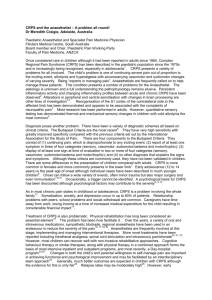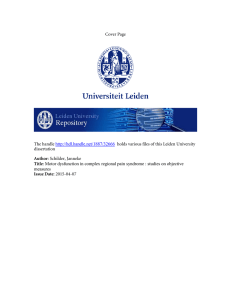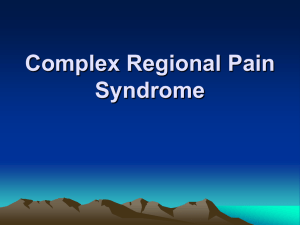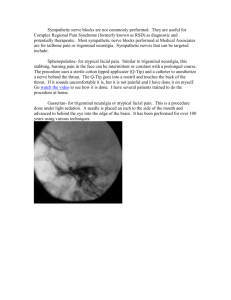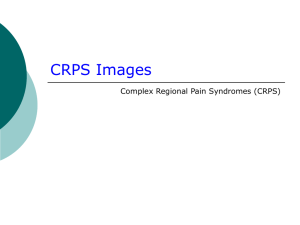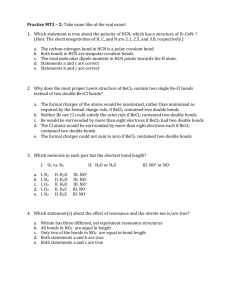Complex Regional Pain Syndrome I (Reflex Sympathetic Dystrophy)
advertisement
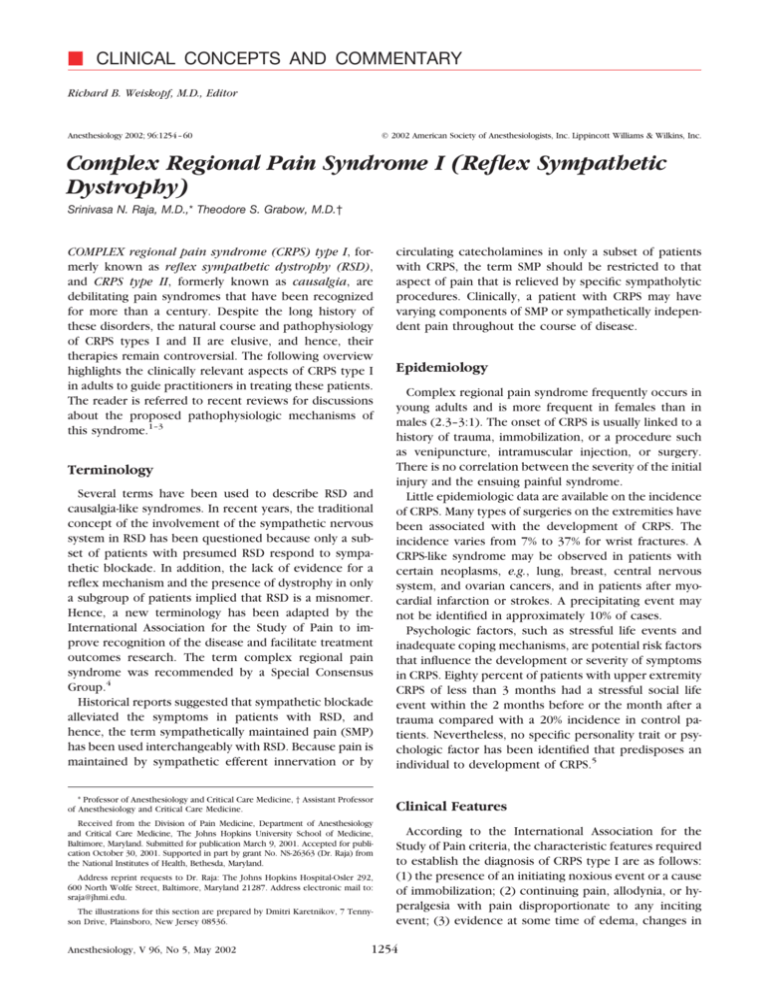
䡵 CLINICAL CONCEPTS AND COMMENTARY Richard B. Weiskopf, M.D., Editor Anesthesiology 2002; 96:1254 – 60 © 2002 American Society of Anesthesiologists, Inc. Lippincott Williams & Wilkins, Inc. Complex Regional Pain Syndrome I (Reflex Sympathetic Dystrophy) Srinivasa N. Raja, M.D.,* Theodore S. Grabow, M.D.† COMPLEX regional pain syndrome (CRPS) type I, formerly known as reflex sympathetic dystrophy (RSD), and CRPS type II, formerly known as causalgia, are debilitating pain syndromes that have been recognized for more than a century. Despite the long history of these disorders, the natural course and pathophysiology of CRPS types I and II are elusive, and hence, their therapies remain controversial. The following overview highlights the clinically relevant aspects of CRPS type I in adults to guide practitioners in treating these patients. The reader is referred to recent reviews for discussions about the proposed pathophysiologic mechanisms of this syndrome.1–3 circulating catecholamines in only a subset of patients with CRPS, the term SMP should be restricted to that aspect of pain that is relieved by specific sympatholytic procedures. Clinically, a patient with CRPS may have varying components of SMP or sympathetically independent pain throughout the course of disease. Epidemiology Several terms have been used to describe RSD and causalgia-like syndromes. In recent years, the traditional concept of the involvement of the sympathetic nervous system in RSD has been questioned because only a subset of patients with presumed RSD respond to sympathetic blockade. In addition, the lack of evidence for a reflex mechanism and the presence of dystrophy in only a subgroup of patients implied that RSD is a misnomer. Hence, a new terminology has been adapted by the International Association for the Study of Pain to improve recognition of the disease and facilitate treatment outcomes research. The term complex regional pain syndrome was recommended by a Special Consensus Group.4 Historical reports suggested that sympathetic blockade alleviated the symptoms in patients with RSD, and hence, the term sympathetically maintained pain (SMP) has been used interchangeably with RSD. Because pain is maintained by sympathetic efferent innervation or by Complex regional pain syndrome frequently occurs in young adults and is more frequent in females than in males (2.3–3:1). The onset of CRPS is usually linked to a history of trauma, immobilization, or a procedure such as venipuncture, intramuscular injection, or surgery. There is no correlation between the severity of the initial injury and the ensuing painful syndrome. Little epidemiologic data are available on the incidence of CRPS. Many types of surgeries on the extremities have been associated with the development of CRPS. The incidence varies from 7% to 37% for wrist fractures. A CRPS-like syndrome may be observed in patients with certain neoplasms, e.g., lung, breast, central nervous system, and ovarian cancers, and in patients after myocardial infarction or strokes. A precipitating event may not be identified in approximately 10% of cases. Psychologic factors, such as stressful life events and inadequate coping mechanisms, are potential risk factors that influence the development or severity of symptoms in CRPS. Eighty percent of patients with upper extremity CRPS of less than 3 months had a stressful social life event within the 2 months before or the month after a trauma compared with a 20% incidence in control patients. Nevertheless, no specific personality trait or psychologic factor has been identified that predisposes an individual to development of CRPS.5 * Professor of Anesthesiology and Critical Care Medicine, † Assistant Professor of Anesthesiology and Critical Care Medicine. Clinical Features Terminology Received from the Division of Pain Medicine, Department of Anesthesiology and Critical Care Medicine, The Johns Hopkins University School of Medicine, Baltimore, Maryland. Submitted for publication March 9, 2001. Accepted for publication October 30, 2001. Supported in part by grant No. NS-26363 (Dr. Raja) from the National Institutes of Health, Bethesda, Maryland. Address reprint requests to Dr. Raja: The Johns Hopkins Hospital-Osler 292, 600 North Wolfe Street, Baltimore, Maryland 21287. Address electronic mail to: sraja@jhmi.edu. The illustrations for this section are prepared by Dmitri Karetnikov, 7 Tennyson Drive, Plainsboro, New Jersey 08536. Anesthesiology, V 96, No 5, May 2002 According to the International Association for the Study of Pain criteria, the characteristic features required to establish the diagnosis of CRPS type I are as follows: (1) the presence of an initiating noxious event or a cause of immobilization; (2) continuing pain, allodynia, or hyperalgesia with pain disproportionate to any inciting event; (3) evidence at some time of edema, changes in 1254 CRPSI (REFLEX SYMPATHETIC DYSTROPHY) 1255 Fig. 1. Clinical features of complex regional pain syndrome type I (reflex sympathetic dystrophy). For definitions of terms, refer to Merskey and Bogduk.31 skin blood flow, or abnormal sudomotor activity in the region of the pain; and (4) the exclusion of medical conditions that would otherwise account for the degree of pain and dysfunction. Motor disturbances and trophic changes, such as altered nail and hair growth, may be observed in some cases. CRPS type II has the same clinical features as CRPS type I except for the presence of clinical signs and history consistent with a nerve injury. The clinical presentation consists of a triad of sensory, autonomic, and motor signs and symptoms (fig. 1).3,6,7 Pain in CRPS varies in quality from a deep ache to a sharp stinging or burning sensation. Often, patients report that the pain is worsened by environmental (cold, humidity) and emotional (anxiety, stress) factors. Cutaneous hypersensitivity presents as pain on contact with clothing or exposure to a cool breeze. The involved extremity is often guarded, even from the examining physician. Patients frequently experience pain from innocuous tactile stimuli (allodynia) and have an increased response to painful stimuli (hyperalgesia). A cooling stimulus, such as a drop of alcohol or acetone in the painful region, may be perceived as painful, especially in the subset of patients with predominantly SMP. Neglect of hygiene is not unusual in the affected limb. Vasomotor changes cause diverse skin discoloration, including various hues of red and purple to mottled, ashen, and gray. The presence of edema in the painful region gives a glossy and smooth appearance to the skin (fig. 1). A difference in skin temperature (either higher or lower of 1°C) is found in only 42% of patients with CRPS, and detectable differences are influenced heavily by ambient temperature. Sudomotor abnormalities range from hyperhidrosis to bone-dry skin. The vasomotor and Anesthesiology, V 96, No 5, May 2002 sudomotor changes are variable not only between patients, but also within individual patients over time.8,9 Motor disturbances in the affected limb may present as tremors, weakness, muscular incoordination, decreased range of movement, muscle spasms, and dystonia. Dystonia in the upper extremity is typified by fingers fixed in flexion, or the clenched-fist syndrome (fig. 1). Dystonia in the lower extremity often presents as an equinovarus position of the foot. Range of movement may be compromised on the affected side, and contractures may develop in severe cases. Considerable variability is observed in the intensity of symptoms, the rapidity of progression of the syndrome, and the response to standard therapies. In a retrospective analysis of more than 1,000 patients, severe complications, such as infection, ulcers, chronic edema, dystonia, and myoclonus, occurred in 7% of patients.10 These complications were more frequent in the lower extremity (65%), in younger female patients, and in patients in whom the acute phase of CRPS was associated with a decreased skin temperature. Infections were usually preceded by ulcerations, edema, or both, and infection was severe enough in one third of patients to require limb amputation. The progression and recurrence of symptoms in CRPS have not been studied prospectively. A recent retrospective analysis of patients with CRPS I identified three different patterns of spread: contiguous spread in all patients, characterized by the gradual enlargement of the area affected from distal to more proximal regions of the limb; independent spread in 70% of patients, depicted by appearance of signs and symptoms at sites distant and noncontiguous from the initial site; and mirror-image spread (15%), typified by appearance of symptoms in the S. N. RAJA AND T. S. GRABOW 1256 opposite limb in a region similar to the site of initial presentation.11 Studies suggest a 4 –10% recurrence of CRPS in the same or another limb between 3 months and 20 yr after the first event. Although most cases occurred after trauma (56%) or surgery (20%), there was no clear etiology in approximately 20% of patients. These observations suggest that the spread of CRPS is not uncommon and raise the issue of whether there is a generalized susceptibility to this condition after CRPS develops. Earlier reports suggested that CRPS may progress through distinct, sequential stages with an early, an intermediate (dystrophic), and a late (atrophic) stage. The latter stage, presumed irreversible, is characterized by trophic changes in skin, nail, and hair (fig. 1) and motor dysfunction resulting from prolonged disuse of the affected region. In a recent multicenter study, a cluster analysis was used to identify relatively homogenous subgroups of patients with CRPS based on their signs and symptoms and the duration of the disease.12 Three subgroups of patients with CRPS were identified. However, these subgroups were not significantly different regarding the duration of CRPS, refuting the traditional view of progressive stages of the disease. The subgroup of patients who exhibited florid CRPS features, including motor or trophic changes and osteopenia, had the briefest disease duration of the three groups. The presumed stages hence may represent subtypes of the disease that are independent of the duration of CRPS. Staging of the disease implies a critical window of opportunity after the development of CRPS for optimal therapeutic results. Therefore, it is commonly advocated that a limited trial of interventions that interrupt sympathetic function should be instituted early in the course of CRPS. However, direct evidence in support of these concepts is lacking. Most patients with CRPS have associated symptoms of psychologic distress. Anxiety, depression, fear, anger, and other psychologic symptoms are considered to be the result and not the cause of CRPS. The signs and symptoms of CRPS may be worsened by illness behaviors, such as disuse and immobilization, or by maladaptive coping skills. Role of the Sympathetic Nervous System There is considerable evidence suggesting that the sympathetic nervous system has a role in chronic neuropathic and inflammatory pain states in both animals and humans (table 1; for details, see Baron et al.2). Preclinical models of neuropathic and inflammatory pain show up-regulation of ␣-adrenergic receptors, adrenergic receptor supersensitivity, and functional coupling between sympathetic efferent and sensory afferent fibers. Clinically, patients with CRPS type I have significant impairment of sympathetic nervous system funcAnesthesiology, V 96, No 5, May 2002 Table 1. Sympathetic Nervous System Involvement after Nerve Injury and Inflammation DRG ⫽ dorsal root ganglia; NE ⫽ norepinephrine. tion13 characterized by decreased sympathetic outflow and increased adrenergic responsiveness in target tissues that may be reversible over time. This alteration of sympathetic function can be generalized (not necessarily limited to the affected extremity),14 which suggests aberrant processing in the central nervous system. Recently, patients with CRPS have been shown to have an increased density of ␣1 adrenoceptors in hyperalgesic skin.15 Diagnosis Clinical Presentation There is no consensus with regard to how many of the different signs and symptoms described in the International Association for the Study of Pain criteria need to be present for an accurate diagnosis. However, CRPS should be suspected if the regional pain and sensory changes after a trauma exceed in magnitude or duration the anticipated healing period. Recent studies on the external and internal validity of the International Association for the Study of Pain criteria suggest that patients should have (1) at least one symptom in each of the following general categories: sensory (hyperesthesia ⫽ increased sensitivity to a sensory stimulation), vasomotor (temperature abnormalities or skin color abnormalities), sudomotor–fluid balance (edema or sweating abnormalities), or motor (decreased range of movement, weakness, tremor, or neglect); and (2) at least one sign within CRPSI (REFLEX SYMPATHETIC DYSTROPHY) two or more of the following categories: sensory (allodynia or hyperalgesia), vasomotor (objective temperature abnormalities or skin color abnormalities), sudomotor–fluid balance (objective edema or sweating abnormalities), or motor (objective decreased range of motion, weakness, tremor or neglect).16,17 Vascular and neurologic examinations will help to detect the presence of conditions that may mimic CRPS. However, currently, there is no test that is easy to perform in the clinical setting to differentiate CRPS from similar pain states of separate origin. Neurologic conditions, such as diabetic and small-fiber peripheral neuropathies, entrapment neuropathies, thoracic outlet syndrome, and discogenic disease, should be excluded. Other differential diagnoses include deep vein thrombosis, cellulitis, vascular insufficiency, lymphedema, and erythromelalgia. Additional Tests Laboratory tests are not essential for the diagnosis of CRPS, but certain additional tests may help to confirm clinical impressions, determine the component of SMP, and design a therapeutic strategy. Tests of sensory (quantitative sensory tests to examine small-fiber function), motor (electromyogram and nerve conduction studies), autonomic (quantitative sudomotor axon-reflex test, thermography, sympathetic block, Doppler flowmetry), and trophic dysfunction (radiograph, bone scintigraphy) have been advocated to reinforce the diagnosis. A recent study suggests that diagnostic accuracy can be improved by incorporating information from laboratory tests into a disease probability scoring system.18 Currently, the prognostic or therapeutic value of any of these tests has not been substantiated by outcomes research. Increased periarticular uptake in delayed bone scintigraphy and demineralization on fine-detail radiography have been used to reinforce disease in the subacute (⬍ 1 yr) and chronic stages, respectively. Nevertheless, the diagnostic use of these tests has been questioned because of the lack of differentiation between characteristic findings in patients with CRPS and patients with posttraumatic syndromes in general. The clinical presentation of CRPS does not help to predict whether the sympathetic nervous system is involved in the generation or maintenance of the pain in a given patient. Selective and specific local anesthetic sympathetic blocks, such as cervicothoracic (stellate) ganglion block for the upper extremity and lumbar sympathetic block for the lower extremity, help to determine the involvement of the sympathetic nervous system. However, the potential for false-positive and false-negative tests and complications associated with these procedures have led to the introduction of an additional placebo-controlled test, the phentolamine infusion test. The rationale for this test is that sympathetic efferents release norepinephrine that is considered to be involved Anesthesiology, V 96, No 5, May 2002 1257 in the generation or maintenance of the pain state. Phentolamine, a nonspecific ␣-adrenergic receptor antagonist, is infused intravenously (1 mg/kg over 10 min) while the patient is blinded to the time of drug administration.19 A significant reduction in pain that is coincident with the time of drug administration implies a role of adrenergic mechanisms in the pain state. Therapy General Strategies Therapies for CRPS types I and II are similar and are guided by the recognition of the complex interaction between psychosocial and biophysical disease and the need for a multidisciplinary approach. In general, there is an incremental incorporation of therapeutic measures that combine aspects of physiotherapeutic, pharmacotherapeutic, and psychotherapeutic modalities (fig. 2). Ultimately, the treatment goal is pain relief, functional recovery, and psychologic improvement. No one therapeutic modality achieves this goal in all patients, and a scientifically proven cure for CRPS does not exist. Numerous treatment modalities have been purported to be useful in the management of CRPS. These include pharmacologic therapies, physiotherapy, behavioral modification and psychotherapy, neuromodulation, surgical procedures, and miscellaneous complementary and alternative therapies. Studies on the role of different treatment strategies for CRPS are difficult to compare because of heterogenous inclusion criteria, inappropriate or absence of adequate controls, lack of adequate power because of small sample sizes, and lack of blinding or randomization. In addition, long-term follow-up studies are scarce. Because the pathophysiologic mechanisms of CRPS are poorly understood, therapy has been directed at managing the signs and symptoms of the disease. Because no single drug has proven to be efficacious for all patients with CRPS, the continual reassessment of the adequacy of pain relief and the careful attention to the side effect profile of drugs are required to make meaningful decisions regarding the initiation or continuation of medications. Medical Therapies (Oral, Topical, Intravenous, Infusion Therapy) Few placebo-controlled trials have determined the therapeutic efficacy of analgesics for patients with CRPS, irrespective of route of injection or technique of drug delivery. Most of the adjuvant drugs currently used for the treatment of neuropathic pain have been used for the treatment of CRPS (see Kingery20 for review). Recently, intravenous infusion of alendronate (bisphosphonate), a powerful inhibitor of bone resorption, was shown to be effective in a randomized, controlled trial in 1258 S. N. RAJA AND T. S. GRABOW Fig. 2. Therapeutic goals and strategies for the management of complex regional pain syndrome (CRPS) type I (reflex sympathetic dystrophy). (Adapted from StantonHicks et al.27) decreasing pain and swelling, and increasing range of motion in patients with CRPS. Other therapies reported to be effective in CRPS include topical dimethyl sulfoxide (a free radical scavenger), topical clonidine, oral corticosteroids, intravenous bretylium, intravenous ketanserin, intravenous phentolamine, intravenous lidocaine, and intranasal calcitonin.20 Systemic ␣ blockers (phenoxybenzamine, prazosin, doxazosin, and terazosin) may be useful in improving peripheral blood flow and tissue perfusion as well as reducing pain in patients with SMP. However, a recent meta-analysis of medical therapies aimed at inhibiting sympathetic function failed to establish the utility of sympathetic blockade.21 Despite controlling for effect size by weighting the methodologic quality of the studies, the variability in diagnostic inclusion criteria between the studies is a confounding factor in this analysis. Finally, the prophylactic administration of high-dose vitamin C in the perioperative period reportedly can decrease the recurrence of symptoms in patients with a previous history of CRPS. Role of Nerve Blocks Historically, interventions that interrupt sympathetic nervous system or adrenergic receptor function were advocated as treatments for CRPS. Despite popular opinion, there is little evidence-based information regarding the proper timing, number, necessity, or appropriateness of nerve blocks for the diagnosis or treatment of CRPS. Scientific progress regarding disease concept and taxonomy has led to a reappraisal of the role of sympathetic ganglionic blockade in CRPS management.22 Nerve blocks are recommended primarily to reduce pain and facilitate physiotherapy and functional rehabilitation. Nevertheless, a retrospective study showed that the Anesthesiology, V 96, No 5, May 2002 prophylactic use of stellate ganglion blocks in patients with a previous history of CRPS decreased recurrence rate of disease from 72% to 10% after reoperation on the affected extremity.23 Neuromodulation Implantable devices, such as spinal cord stimulators, are being increasingly used in intractable CRPS to produce symptomatic relief. Neuromodulatory modalities include peripheral nerve, spinal cord, and thalamic stimulation. The efficacy of most of these therapies has not been shown by placebo-controlled trials in CRPS patients. In a recent prospective, randomized, controlled study, patients with CRPS who received spinal cord stimulation combined with physiotherapy obtained greater pain relief and improvement in health-related quality of life compared with patients who received physiotherapy alone.24 Spinal cord stimulation produced analgesia in patients with CRPS who had undergone previous sympathectomy. This observation suggests that spinal cord stimulation–mediated analgesia can be produced without inhibition of sympathetic function in patients with CRPS.25 Although spinal cord stimulation does produce inhibition of sympathetic outflow, its mechanism of action is diverse and likely involves neurochemical changes at both spinal and supraspinal targets. In particular, spinal cord stimulation may have an inhibitory effect on A- fiber–mediated hyperexcitability of dorsal horn neurons through a ␥-aminobutyric acid (GABA)–mediated mechanism. The observation that patients can receive analgesia without alteration of sympathetic function suggests that pain and sympathetic function are not interdependent in all patients. This is supported by the finding that impairment of sympathetic function shows no correlation with clin- CRPSI (REFLEX SYMPATHETIC DYSTROPHY) ical symptoms of disease, such as pain, edema, or temperature differences, in patients with CRPS.13 Epidural and Intrathecal Drug Administration Epidural clonidine has been reported to be beneficial in patients with CRPS in a double-blind controlled trial. Intrathecal drug therapy has been advocated for patients with CRPS refractory to conventional modalities based predominantly on case reports. A recent controlled study in seven patients with CRPS showed the efficacy of intrathecal baclofen for the treatment of dystonia.26 A reduction in pain, autonomic, and sensory symptoms was observed in a subset of these patients after chronic infusion of intrathecal baclofen. These preliminary findings are particularly important given the fact that the treatment of severe dystonia with physiotherapy or surgery (tenotomy, tenoplasty) has been unsatisfactory. Neuroablative Therapies Surgical or chemical sympathectomy and radiofrequency ablation of sympathetic ganglia are options when conservative therapies have failed. The diagnosis of SMP should be confirmed with placebo-controlled tests before considering sympathectomy as a therapeutic option. However, a potential risk of sympathectomy is the development of postsympathectomy neuralgia, which may represent denervation supersensitivity of adrenoceptors. Amputations of the affected limb have been performed for pain refractory to medical therapy, for limbs with recurrent infections, and to improve residual function. Unfortunately, relief of pain is achieved only in a minority of patients after amputation. Functional Rehabilitation with Physiotherapy The primary objective of physiotherapeutic modalities is goal-oriented functional restoration. The algorithm for physiotherapy can be divided into four general steps that should be customized to individual needs: (1) desensitization of the affected region; (2) mobilization, edema control, and isometric strengthening; (3) stress loading, isotonic strengthening, range of motion, postural normalization, and aerobic conditioning; and (4) vocational and functional rehabilitation as well as ergonomic reconditioning.27 In general, progression through physiotherapy will require concurrent application of psychological and pharmacological modalities. Despite the widespread conviction that physiotherapeutic modalities are beneficial for patients with CRPS, the effect of physiotherapy on the natural course of disease is unknown. To date, only the short-term efficacy of physical therapy compared with placebo therapy has been shown for patients with CRPS.28 Behavioral Modification and Psychiatric Consultation The recent International Association for the Study of Pain consensus report recommends that patients with Anesthesiology, V 96, No 5, May 2002 1259 pain less than 2 months in duration generally do not require formal psychological intervention.27 The panel of experts recommended that after 2 months, patients with CRPS should receive psychological evaluation, including psychometric testing, to identify and treat psychological disease, such as anxiety, depression, or personality disorder. All factors that contribute to patient disability should be determined. Counseling, behavioral modification, biofeedback, relaxation therapy, group therapy, and self-hypnosis should be considered. Therapies aimed at improving patient motivation and coping skills are necessary. For patients with pain longer than 6 months in duration, additional psychological testing may be warranted. Despite the fact that principles derived from cognitive behavioral theory are effective for treatment of chronic pain in general,29 the value of cognitive– behavioral psychotherapy and psychometric testing specifically for patients with CRPS has not been fully determined. Prognosis The World Health Organization acknowledges the existence of a sequence between disease—impairment— disability, and handicap. A 5-yr follow-up study of patients with upper extremity CRPS revealed that patients continue to have impairments and disabilities in activities of daily living. Severe cases of CRPS may lead to marked limitation of function and even amputation of the affected limb. A 5-yr follow-up study in The Netherlands of patients with CRPS of the upper extremity indicated that 26% of patients had to change their jobs, and nearly 30% of patients had to stop work for more than a year. However, 72% continued to work full time.30 Although most experts agree that the prognosis is poor when symptoms become chronic, the prognostic implications regarding the occurrence, timing, or intensity of the variety of sensory, motor, trophic, or autonomic disturbances that occur throughout the course of the disease are unknown. References 1. Reflex Sympathetic Dystrophy: A Reappraisal. Edited by Janig W, StantonHicks M. Seattle, IASP Press, 1996 2. Baron R, Levine JD, Fields HL: Causalgia and reflex sympathetic dystrophy: Does the sympathetic nervous system contribute to the generation of pain? Muscle Nerve 1999; 22:678 –95 3. Galer BS, Schwartz L, Allen RJ: Complex regional pain syndromes—type I: Reflex sympathetic dystrophy, and type II: Causalgia, Bonica’s Management of Pain, 3rd edition. Edited by Loeser JD. Philadelphia, Lippincott Williams & Wilkins, 2001, pp 388 – 411 4. Stanton-Hicks M, Janig W, Hassenbusch S, Haddox JD, Boas R, Wilson P: Reflex sympathetic dystrophy: Changing concepts and taxonomy. Pain 1995; 63:127–33 5. Lynch ME: Psychological aspects of reflex sympathetic dystrophy: A review of the adult and paediatric literature. Pain 1992; 49:337– 47 6. Veldman PH, Reynen HM, Arntz IE, Goris RJ: Signs and symptoms of reflex sympathetic dystrophy: Prospective study of 829 patients. Lancet 1993; 342: 1012– 6 7. Wasner G, Backonja MM, Baron R: Traumatic neuralgias: Complex regional 1260 pain syndromes (reflex sympathetic dystrophy and causalgia): Clinical characteristics, pathophysiological mechanisms and therapy. Neurol Clin 1998; 16:851– 68 8. Birklein F, Riedl B, Neundorfer B, Handwerker HO: Sympathetic vasoconstrictor reflex pattern in patients with complex regional pain syndrome. Pain 1998; 75:93–100 9. Wasner G, Heckmann K, Maier C, Baron R: Vascular abnormalities in acute reflex sympathetic dystrophy (CRPS I): Complete inhibition of sympathetic nerve activity with recovery. Arch Neurol 1999; 56:613–20 10. van der Laan L, Veldman PH, Goris RJ: Severe complications of reflex sympathetic dystrophy: Infection, ulcers, chronic edema, dystonia, and myoclonus. Arch Phys Med Rehabil 1998; 79:424 –9 11. Maleki J, LeBel AA, Bennett GJ, Schwartzman RJ: Patterns of spread in complex regional pain syndrome, type I (reflex sympathetic dystrophy). Pain 2000; 88:259 – 66 12. Bruehl S, Harden RN, Galer BS, Saltz S, Backonja M, and Stanton-Hicks, M: Complex regional pain syndrome: Are there distinct subtypes and sequential stages of the syndrome? Pain 2002; 95:119 –24 13. Schurmann M, Gradl G, Andress HJ, Furst H, Schildberg FW: Assessment of peripheral sympathetic nervous function for diagnosing early post-traumatic complex regional pain syndrome type I. Pain 1999; 80:149 –59 14. Schurmann M, Gradl G, Zaspel J, Kayser M, Lohr P, Andress HJ: Peripheral sympathetic function as a predictor of complex regional pain syndrome type I (CRPS I) in patients with radial fracture. Auton Neurosci 2000; 86:127–34 15. Drummond PD, Skipworth S, Finch PM: Alpha 1-adrenoceptors in normal and hyperalgesic human skin. Clin Sci (Colch) 1996; 91:73–7 16. Bruehl S, Harden RN, Galer BS, Saltz S, Bertram M, Backonja M, Gayles R, Rudin N, Bhugra MK, Stanton-Hicks M: External validation of IASP diagnostic criteria for complex regional pain syndrome and proposed research diagnostic criteria. Pain 1999; 81:147–54 17. Harden RN, Bruehl S, Galer BS, Saltz S, Bertram M, Backonja M, Gayles R, Rudin N, Bhugra MK, Stanton-Hicks M: Complex regional pain syndrome: Are the IASP diagnostic criteria valid and sufficiently comprehensive? Pain 1999; 83: 211–9 18. Sandroni P, Low PA, Ferrer T, Opfer-Gehrking TL, Willner CL, Wilson PR: Complex regional pain syndrome I (CRPS I): Prospective study and laboratory evaluation. Clin J Pain 1998; 14:282–9 Anesthesiology, V 96, No 5, May 2002 S. N. RAJA AND T. S. GRABOW 19. Wesselmann U, Raja SN: Reflex sympathetic dystrophy/causalgia. Anesthesiol Clin North Am 1997; 15:407–27 20. Kingery WS: A critical review of controlled clinical trials for peripheral neuropathic pain and complex regional pain syndromes. Pain 1997; 73:123–39 21. Perez RS, Kwakkel G, Zuurmond WW, de Lange JJ: Treatment of reflex sympathetic dystrophy (CRPS type 1): A research synthesis of 21 randomized clinical trials. J Pain Symptom. Manage 2001; 21:511–26 22. Boas RA: Sympathetic nerve blocks: In search of a role. Reg Anesth Pain Med 1998; 23:292–305 23. Reuben SS, Rosenthal EA, Steinberg RB: Surgery on the affected upper extremity of patients with a history of complex regional pain syndrome: A retrospective study of 100 patients. J Hand Surg [Am] 2000; 25:1147–51 24. Kemler MA, Barendse GA, van Kleef M, De Vet HC, Rijks CP, Furnee CA, van den Wildenberg FA: Spinal cord stimulation in patients with chronic reflex sympathetic dystrophy. N Engl J Med 2000; 343:618 –24 25. Kemler MA, Barendse GA, van Kleef M, Egbrink MG: Pain relief in complex regional pain syndrome due to spinal cord stimulation does not depend on vasodilation. ANESTHESIOLOGY 2000; 92:1653– 60 26. van Hilten BJ, van de Beek WJ, Hoff JI, Voormolen JH, Delhaas EM: Intrathecal baclofen for the treatment of dystonia in patients with reflex sympathetic dystrophy. N Engl J Med 2000; 343:625–30 27. Stanton-Hicks M, Baron R, Boas R, Gordh T, Harden N, Hendler N, Koltzenburg M, Raj P, Wilder R: Complex regional pain syndromes: Guidelines for therapy. Clin J Pain 1998; 14:155– 66 28. Oerlemans HM, Oostendorp RA, de Boo T, Goris RJ: Pain and reduced mobility in complex regional pain syndrome I: Outcome of a prospective randomised controlled clinical trial of adjuvant physical therapy versus occupational therapy. Pain 1999; 83:77– 83 29. Morley S, Eccleston C, Williams A: Systematic review and meta-analysis of randomized controlled trials of cognitive behaviour therapy and behaviour therapy for chronic pain in adults, excluding headache. Pain 1999; 80:1–13 30. Geertzen JH, Dijkstra PU, Groothoff JW, ten Duis HJ, Eisma WH: Reflex sympathetic dystrophy of the upper extremity: A 5.5-year follow-up: II. Social life events, general health and changes in occupation. Acta Orthop Scand Suppl 1998; 279:19 –23 31. Merskey H, Bogduk N: Classification of Chronic Pain, 2nd edition. Seattle, IASP Press, 1994
